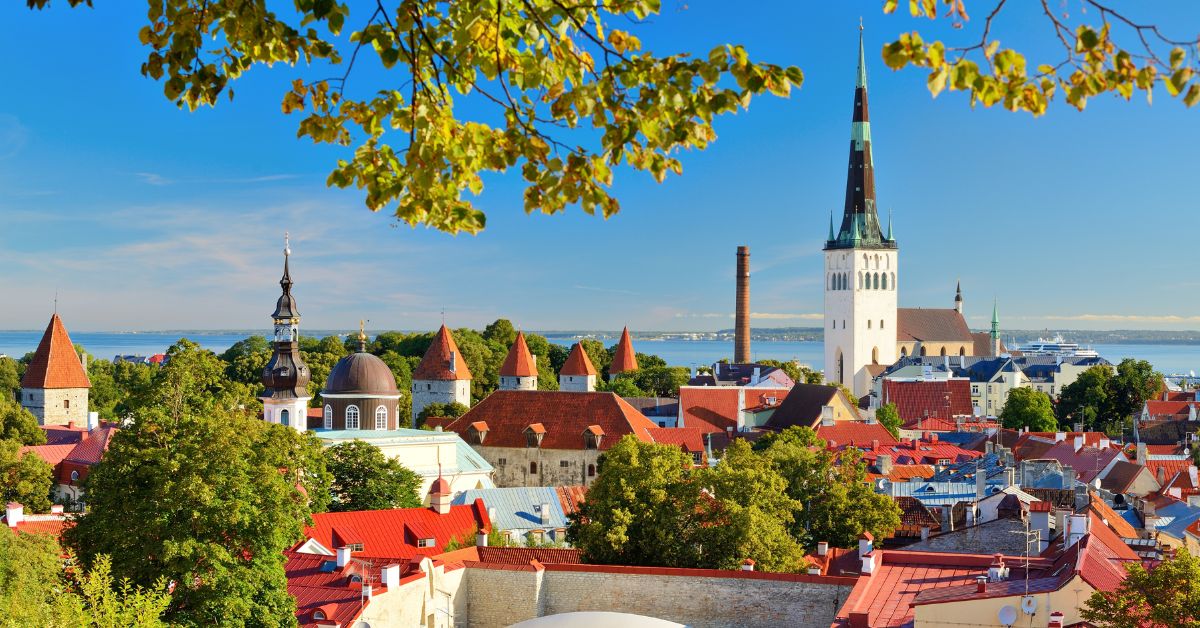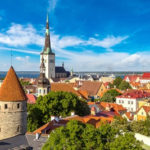Estonia first introduced what is now known as a digital nomad visa in 2020. At the time, the visa program was the first of its kind, and yet, it anticipated a work revolution (and world) where freedom of movement and autonomy are highly valued by workers.
In the following article, we’ll break down the two types of digital nomad visas available to remote workers, discuss the application requirements and eligibility associated with each one, and showcase the best places to live in Estonia for digital nomads.
Snapshot of expat life in Estonia
Population: Over 3 million
Capital city: Tallinn
Currency: Euro
Official language(s): Estonian
How Estonia came to be at the forefront of the digital nomad phenomenon
Digital nomad visas are a great way for countries to attract residents who will stimulate their economies without adding competition to the local job market. While many countries have only begun catering to digital nomads in earnest in the past few years, Estonia is significantly ahead of the curve.
In 2014, the Estonian government launched a ground-breaking e-Residency program. After the success of that program, they became the first country in the world to launch a full-on digital nomad visa in July 2020, even as many countries remained closed to foreign visitors.
Perhaps it’s no surprise, then, that Estonia has become a hotspot for startups and innovators1 not just in the Schengen area, but the world in general.
The country is currently home to the most “unicorn” startups2 — aka startups valued at a billion dollars or more — per capita in the world, including companies like Bolt, Wise, and Skype.
What is the difference between e-Residency and the digital nomad visa?
While there’s a good amount of overlap between the type of people who apply to Estonia’s e-Residency program and the digital nomad visa, there are a few key differences.
| e-Residency | Digital Nomad Visa |
|---|---|
| Intended for entrepreneurs | Geared toward remote workers in general, which can include employees as well |
| Allows entrepreneurs to remotely base their companies in Estonia in order to grant them tax and legal benefits, but not to live in the country | Allows remote workers to legally live and work in Estonia for up to one year |
| Applications for e-Residency are made online, with the process taking 3-8 weeks | Applications for the digital nomad visa at your nearest Estonian embassy, with the process taking up to 30 days3 |
Two types of digital nomad visas in Estonia
There are two types of digital nomad visas in Estonia, and the main difference between them is the amount of time granted to the visa holder.
Estonia Type C Digital Nomad Visa
The Type C digital nomad visa is a short-stay visa that allows holders to live and work in Estonia for up to 90 days.
Estonia Type D Digital Nomad Visa
The Type D digital nomad visa is a long-stay visa that allows holders to live and work in Estonia for up to one year.
Requirements and process to become a digital nomad in Estonia
As you dig into the application process for the Estonia digital nomad visa, you’ll want to carefully note your eligibility and organize the necessary documents required for the application.
Application eligibility
To apply for a digital nomad in Estonia, you must meet the following requirements:
- Be able to do remote work via telecommunications technology (the internet)
- Meet one of the following three conditions:
- Be employed by a company registered in another country
- Work as a consultant/freelancer primarily for clients registered in another country/countries
- Serve as a partner/shareholder for an employer in another country
- Earn a monthly income of at least €4,500 gross of taxes (i.e., before taxes)
Application materials and visa duration
You must include the following required documents as part of your digital nomad visa application:
- A completed visa application form
- A valid passport
- A clean criminal background check
- A written explanation detailing how you plan to telework from Estonia
- A letter from your employer(s) confirming that you can perform your duties remotely
- An employment contract or contract for services rendered
- Documentation that details your state/local tax and social security obligations
- Documentation containing information on your employer/clients, including the name, location, industry, your role, and their legal representatives
- Proof of income of at least €4,500 per month over the past six months
- A travel medical insurance contract for the duration of your stay in Estonia
Once granted, type C visas last up to 90 days, while type D visas last up to one year. While these visas can’t be renewed, you can apply for a new one six months after the initial one has expired.
Permitted activities and work restrictions
While Estonian digital nomad visas allow foreigners to legally live and work remotely in Estonia,4 keep in mind that you cannot work primarily for or with companies based in Estonia itself.
What’s more, the visa is not a residence permit, nor does it provide a path to permanent residency in Estonia. The most you can stay in the country is 548 days out of a period of 730 consecutive days; and after 1.5 years in Estonia, you must leave.
In summary: The Estonia digital nomad visa application process

To apply for a digital nomad visa in Estonia, you must:
- Confirm that you meet the requirements
- Fill out the application form
- Gather the required documents mentioned above
- Note: All documents must be in English, Estonian, or Russian
- Make an appointment at your nearest Estonian embassy or consulate (if necessary; some locations allow drop-ins)
- Submit your documents in person
- Pay the associated fee (€90 for a C-visa, €100 for a D-visa)
- Receive approval (typically within 15-30 days of submission)
- Return to the Estonian embassy or consulate to verify your identity and pick up your visa
- Book your travel to and pack your bags for Estonia!
Note: The official Estonian website has an excellent and comprehensive FAQ section for prospective digital nomads!
Where to live in Estonia
There are plenty of great places to live in Estonia, many of which offer a reasonable cost of living. Below, we’ve highlighted three cities as excellent choices for digital nomads.
Tallinn
Tallinn, the enchanting capital of Estonia, offers a perfect blend of medieval charm and modern vitality. Cobblestone streets, a picturesque Old Town, and ancient forts coexist alongside an innovative tech industry, vibrant arts scene, and lively cafés. And as the top hub for digital nomads, you’ll have plenty of opportunities to form friendships with like-minded individuals.
Tartu
The lively university town of Tartu exudes a youthful, intellectual feel. Among historic architecture, tree-lined avenues, and scenic parks, you’ll find students and young professionals around every corner. Whether you’re into concerts, craft beer, or avant-garde art performances, you’re sure to find your niche in this distinctive, inviting town.
Pärnu
If you’re looking for a seaside getaway, you’d be hard-pressed to find a better option in Estonia than Pärnu, a charming coastal town with a laid-back and leisurely vibe. Locals and visitors alike enjoy leisurely strolls and bike rides along the beautiful promenade, with sun-soaked beaches, spas, and outdoor dining just a stone’s throw away.
Digital nomad life in Estonia
There’s a nearly endless amount of places to go and things to do when living or traveling in Estonia — but whatever you do, make sure not to skip these five activities.
5 things that should be on your Estonia bucket list5
- Explore the underwater prison in Ruumu
- Stroll along the Türisalu Cliff
- Visit the Ruhnu Lighthouse
- Admire Estonia’s brown bears (from a safe distance!)
- Have a bowl of soup in Supilinn, the quirky town where every street is named for a type of soup
Expat community in Estonia – how to find your people
It’s normal to feel unsure and even a little lonely when you move to a new country. Fortunately, Estonia is bursting with opportunities to get out and meet new people — you’ll be making new friends in no time.
Moving to Estonia
Before making the leap to becoming a digital nomad in Estonia, make sure you cross the following off of your to-do list:
- Gather all of your important documents (passport, visa, etc.)
- Set up a doctor’s appointment to get any vaccines or medications you might need
- Buy tickets for your flights both into and out of Estonia
- Book accommodations for your arrival
- Research what to bring, create a list, and pack your bags
- Flag your travel plans to your bank so they don’t mark purchases abroad as suspicious
- Set up a forwarding address for your mail, if necessary
- Connect with other digital nomads in Estonia for advice on sites like Reddit or Facebook
Pro tip:
Consider connecting with a CPA specialized in US expat taxes prior to leaving; depending on your situation, a proactive tax planning approach could be a financially savvy move.
Estonia digital nomad visa taxes
If you reside in Estonia for more than 183 days, then you become a tax resident. US citizens living as digital nomads in Estonia with the Estonia Type D Digital Nomad Visa will be taxed at a flat rate of 20%.
Additionally, Estonia and the United States do have a tax treaty that prevents double taxation. However, most tax treaties include a Savings Clause provision that states that the US can tax its citizens as if the treaty did not exist in the first place. The clause generally prevents the US citizen taxpayer living abroad from taking advantage of the treaty’s contents.
That being said, some exceptions to this saving clause exist, providing a narrow but existent window of application of the tax treaty for US taxpayers living abroad.
VAT in Estonia
Currently, the general VAT rate is 20%. However, from January 2024, that rate will increase to 22%.
Do US digital nomads in Estonia have to pay US taxes?
America’s tax system requires all citizens and permanent residents to file a federal tax return (provided that they meet the minimum income reporting threshold) regardless of where in the world they live and regardless of whether there’s a Tax Treaty in place. However, US citizens living abroad may not necessarily owe US taxes.
Expat tax provisions for Americans filing US taxes in Estonia
Moving abroad may complicate your taxes and can feel overwhelming to navigate. Below are some of the additional reporting obligations tax breaks expats should read up on.
Foreign Earned Income Exclusion (FEIE)
The FEIE allows you to exclude a certain amount of foreign-earned income from taxation ($112,000 for tax year 2022, $120,000 for tax year 2023).
To be eligible, you need to pass either the Physical Presence Test or Bona Fide Residence Test. If you qualify, you’re also eligible for the Foreign Housing Exclusion/Deduction, which allows you to write off qualifying housing expenses like rent and utilities.
Foreign Tax Credit (FTC)
The FTC allows you to subtract what you pay in income taxes to a foreign government from what you owe the US government in income taxes if those taxes were driven by foreign-sourced income.
Foreign Bank Account Report (FBAR)
If you have $10,000 or more in foreign bank accounts at any point in the year, you’ll need to report the contents of those accounts to the Financial Crimes Enforcement Network (FinCEN) via FinCEN Report 114.
Foreign Account Tax Compliance Act (FATCA)
If you have over $200,000 in foreign assets by the last day of the tax year, or over $300,000 in foreign assets at any point during the tax year, FATCA you might be required to file Form 8938.
Digital Nomad in Estonia - FAQ
-
Is Estonia a good place to live?
Estonia is widely regarded as a society at the forefront of digitization and has an excellent startup ecosystem. Additionally, quality of life is high, with the cost of living being manageable and natural factors such as beautiful forests and extremely clean air creating optimal conditions for living abroad.

 Connect on LinkedIn
Connect on LinkedIn






